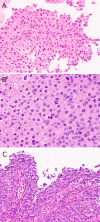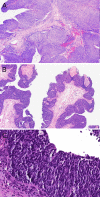Low Grade Papillary Sinonasal (Schneiderian) Carcinoma: A Series of Five Cases of a Unique Malignant Neoplasm with Comparison to Inverted Papilloma and Conventional Nonkeratinizing Squamous Cell Carcinoma
- PMID: 34041710
- PMCID: PMC8633211
- DOI: 10.1007/s12105-021-01335-3
Low Grade Papillary Sinonasal (Schneiderian) Carcinoma: A Series of Five Cases of a Unique Malignant Neoplasm with Comparison to Inverted Papilloma and Conventional Nonkeratinizing Squamous Cell Carcinoma
Abstract
There have been a few case reports and one small series of low grade papillary sinonasal (Schneiderian) carcinomas (LGPSC) which mimic papillomas but have overtly invasive growth and which occasionally metastasize. We describe the morphologic, clinical, immunohistochemical, and molecular features of five patients with LGPSC compared with eight cases each of inverted papilloma (IP) and conventional nonkeratinizing squamous cell carcinoma (SCC) with papillary growth. All LGPSC were nested with predominantly pushing invasion, no stromal reaction, and frequent surface papillary growth. All consisted of one cell type only, with polygonal cells with round nuclei, no (or limited) cytologic atypia, low mitotic activity, and prominent neutrophilic infiltrate. One patient had slightly more infiltrative bone invasion, another lymphovascular, perineural, and skeletal muscle invasion, and a third nodal metastasis after 17 years. By comparison, IPs had bland cytology, neutrophilic microabscesses, mixed immature squamous, goblet cell, and respiratory epithelium, and extremely low mitotic activity. Nonkeratinizing SCCs had basaloid-appearing cells with nuclear pleomorphism, brisk mitotic activity, and apoptosis. All LGPSC were p63 positive. Mitotic activity and Ki67 indices were significantly higher for LGPSCs than IPs and significantly lower than NKSCCs, while p53 immunohistochemistry in LGPSC was identical to nonkeratinizing SCC and higher than for IP. Sequencing showed all five tumors to harbor a MUC6 mutation, one tumor to harbor CDKN2A and PIK3R1 mutations, and one tumor to harbor a NOTCH1 mutation. All LGPSC lacked EGFR and KRAS mutations and lacked copy number variations of any main cancer genes. At a median follow up of 12 months, two LGPSC recurred locally, and one patient died after massive local recurrences and nodal metastases. LGPSC is a distinct, de novo sinonasal carcinoma that can be differentiated from papillomas by morphology and selected immunohistochemistry.
Keywords: Human papillomavirus; Low grade papillary sinonasal carcinoma; Nonkeratinizing squamous cell carcinoma; Papilloma; Sinonasal; p16.
© 2021. The Author(s), under exclusive licence to Springer Science+Business Media, LLC, part of Springer Nature.
Conflict of interest statement
Dr. Chernock is a member of the Precision Oncology Alliance of Caris Life Sciences, Inc., which is an unpaid role where she provides research guidance. She has no other potential conflicts of interest, financial or otherwise, to report, and neither do any of the remaining authors.
Figures






References
-
- El-Naggar A, Grandis JR, Chan JK, et al., editors. WHO classification of head and neck tumours. 4th ed. Lyon: IARC Press; 2017.
-
- Bishop JA, Brandwein-Gensler M, Nicolai P, et al. et al. Nonkeratinizing squamous cell carcinoma. In: El-Naggar A, Grandis JR, Chan JK, et al.et al., editors. WHO classification of head and neck tumors. Lyon: IARC Press; 2017. pp. 15–17.
Publication types
MeSH terms
Substances
LinkOut - more resources
Full Text Sources
Other Literature Sources
Research Materials
Miscellaneous

